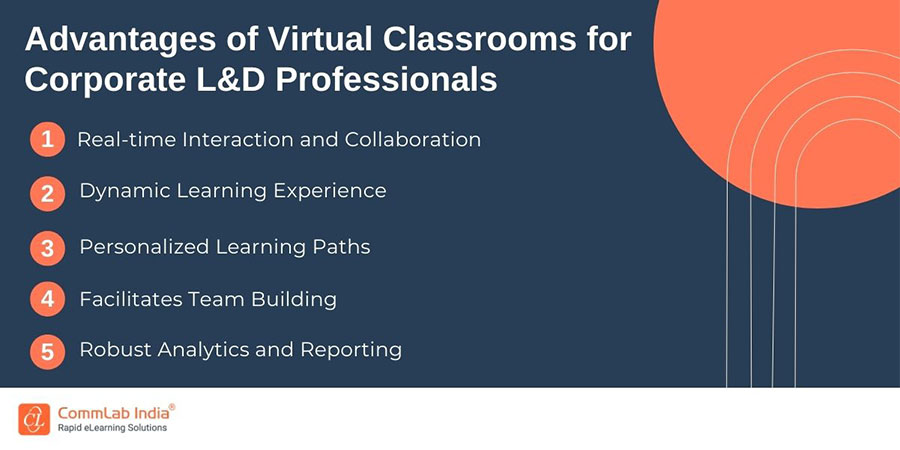Webinars vs. Virtual Classrooms: Decoding the eLearning Dilemma
Virtual classrooms or webinars... what’s the best choice for corporate training? Read on to explore.

Imagine this : You're the head of Learning and Development in a thriving multinational corporation, navigating the dynamic seas of corporate training. Your goal is clear — to empower your teams with knowledge and skills in an ever-evolving digital landscape. Now, at the crossroads of innovation, two titans stand before you: webinars and virtual classrooms. Each promises a gateway to effective eLearning, and as an L&D professional, the choice between them holds the key to unlocking the future of your team's development. Join us on an exhilarating journey as we dissect the strengths, weaknesses, and overall impact of webinars and virtual classrooms in the pulsating realm of corporate training. It's time to unravel the digital tapestry and discover who emerges victorious in this clash of eLearning titans.
Virtual Classrooms vs. Webinars: When to Choose What!
Choose webinars when delivering large-scale presentations or disseminating information to a broad audience. Opt for virtual classrooms when real-time interaction, collaboration, and a dynamic learning experience are essential, fostering engagement and personalized learning paths. Virtual classrooms excel in team building, making them ideal for dispersed or remote teams. Ultimately, the decision hinges on specific training goals and the level of interactivity required for a successful learning outcome.
Navigating eLearning: Webinars vs. Virtual Classrooms
Before we embark on our journey to compare webinars and virtual classrooms in detail, let's briefly understand each format's fundamental characteristics.
Webinars for Corporate Training
Webinars, short for web seminars, are online learning events that facilitate communication between a presenter and a remote audience. Typically one-way, webinars are ideal for delivering presentations, conducting product demonstrations, or disseminating information to a large audience. Interaction in webinars is often limited to features like Q&A sessions, polls, and chat functionalities.
Advantages of Webinars for Corporate L&D Professionals

1. Scalability : Webinars can reach a large audience simultaneously, making them ideal for disseminating information, conducting company-wide presentations, or hosting events with broad participation.
2. Cost-Effectiveness: Webinars are generally cost-effective, eliminating expenses related to venue bookings, travel, and accommodation. This makes them a budget-friendly option for organizations looking to maximize the impact of their training or informational sessions.
3. Convenience and Accessibility: Offering unparalleled convenience, webinars enable participants to join from anywhere with an internet connection. Additionally, recorded webinars provide flexibility for on-demand access, overcoming geographical barriers and ensuring accessibility for a diverse audience.
Virtual Classrooms for Corporate Training
Virtual classrooms, on the other hand, provide a more interactive and collaborative online learning environment. These sessions support two-way communication, allowing real-time interaction between instructors and participants. Virtual classrooms often feature breakout rooms, collaborative documents, instant messaging, and other tools that foster engagement and active participation.
→ Download Now: Classroom to eLearning Conversion - Everything You Always Wanted to Know [eBook]
Advantages of Virtual Classrooms for Corporate L&D Professionals

1. Real-time Interaction and Collaboration : One of the primary strengths of virtual classrooms is the potential to foster real-time interaction and collaboration. Corporate L&D professionals can use features like live discussions, group activities, and instant feedback to build an engaging learning environment. This encourages participants to actively contribute to the learning experience.
2. Dynamic Learning Experience : Virtual classrooms offer advanced learning experiences that go beyond the passive consumption of content. L&D professionals can leverage interactive training tools, such as whiteboards, quizzes, and collaborative documents, to keep participants actively involved. This active approach improves learning retention and provides a better understanding of the material.
3. Personalized Learning Paths : Virtual classrooms allow for a degree of personalization in the learning experience. L&D professionals can tailor content, discussions, and activities to meet the specific needs of participants. This adaptability ensures that employees receive relevant information and skills, maximizing the impact of the training program on individual performance and overall organizational goals.
4. Facilitates Team Building: For organizations with dispersed teams or remote workers, virtual classrooms serve as a valuable tool for team building. L&D professionals can design collaborative exercises, group projects, and discussions that promote teamwork and connectivity among participants. This becomes especially crucial in fostering a sense of belonging and camaraderie within a distributed workforce.
5. Robust Analytics and Reporting: Virtual classrooms often come equipped with robust analytics tools that provide valuable insights into participant engagement and performance. L&D professionals can track attendance, participation levels, and quiz scores to assess the effectiveness of the training session. This data-driven approach enables continuous improvement and refinement of future virtual classroom experiences.
Virtual Classrooms vs. Webinars: Choosing the Right Course
While virtual classrooms offer compelling advantages, the choice between webinars and virtual classrooms ultimately depends on the specific goals and requirements of the corporate L&D initiative. For some specific scenarios, webinars may be the best choice, like when making company-wide announcements or when hosting large-scale presentations.
However, when fostering interactivity, collaboration, and a personalized learning experience is the priority, virtual classrooms emerge as the preferred option for corporate L&D professionals. The dynamic nature of virtual classrooms aligns well with the evolving needs of modern workplaces, where active engagement and real-time collaboration are critical for employee development.
Here's a Video on How to Maximize Impact in the Virtual Classroom:
Summing Up
As corporate L&D professionals navigate the eLearning landscape, the decision between webinars and virtual classrooms becomes pivotal. By recognizing the unique advantages that virtual classrooms offer, L&D professionals can strategically deploy these sessions to create a more engaging and impactful learning experience for their teams. It's not just about choosing a format; it's about charting a course that aligns with the organization's learning objectives and empowers employees to thrive in a dynamic business environment. So, whether sailing through the waters of webinars or cruising in the collaborative seas of virtual classrooms, the key lies in understanding the needs of your organization and steering toward effective and engaging eLearning solutions.
Ready to revolutionize your training approach? Dive deeper into the world of Classroom to eLearning Conversion with our comprehensive guide. Uncover the secrets to seamless transitions, enhanced engagement, and measurable success.





